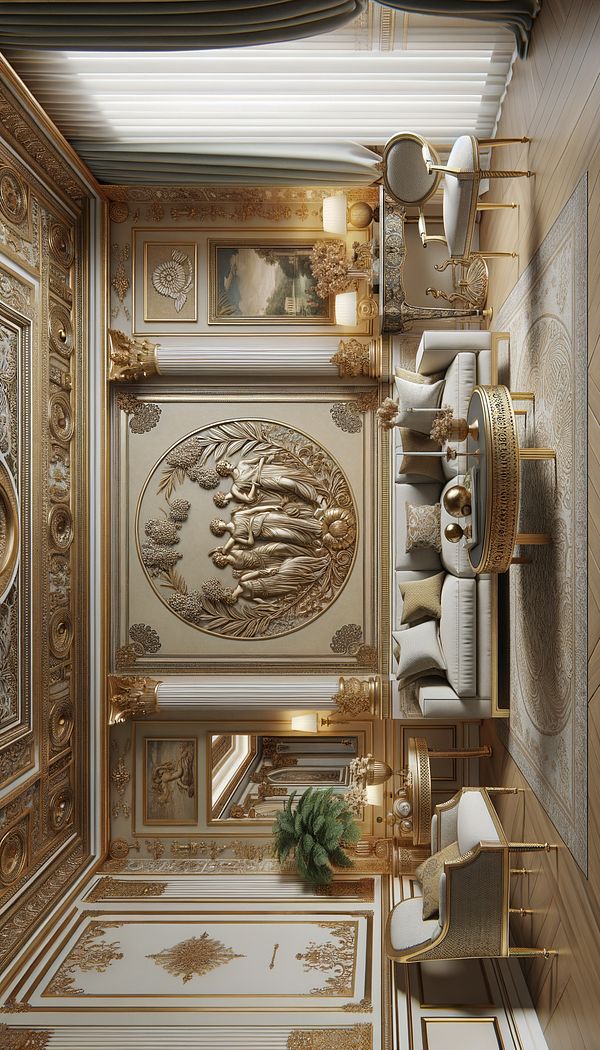What is Anthemion?
Anthemion is a design motif consisting of a radial cluster of palm leaves or floral patterns.
Description
Anthemion, an artistic motif that is widely recognized for its decorative appeal, consists of a radial cluster of palm leaves or floral patterns reminiscent of honeysuckle. This decorative element is synonymous with classical architecture and design, illustrating an affinity for the natural elegance found in Greek and Roman aesthetics. Its application spans across various mediums, including architectural friezes, pottery, textiles, and metalwork, showcasing its versatility and enduring popularity in design circles.
Within the context of interior design, anthemion serves as a bridge between classical splendor and contemporary style. By integrating this motif into modern environments, designers are able to evoke a sense of sophistication and timeless elegance. Whether through wallpaper patterns, fabric designs, metal accents, or carved wood details, the anthemion motif adds a layer of visual interest and historical depth to a space.
Moreover, the symbolism associated with the anthemion—growth, fertility, and purity—resonates with the thematic undercurrents of many spaces, adding an additional layer of meaning to the decor. This fusion of beauty, functionality, and symbolism is what makes the anthemion an enduring and fascinating element in design.
Usage
In interior design, anthemion patterns are often found in wallpaper designs, fabric prints, decorative ceramics, and architectural elements such as cornices and friezes. The motif can also be seen in the design of furniture, where carved or embossed anthemion patterns add a classical touch to pieces such as headboards, table legs, and mirror frames. In more contemporary settings, designers might use anthemion motifs in metal fixtures or as inspiration for modern artwork, creating a blend of classical and modern aesthetics.
FAQs
-
Where did the anthemion motif originate?
The anthemion motif originated in ancient Greek and Roman art, where it was commonly used to decorate architectural elements, pottery, and textiles. It reflects the classical world's appreciation for natural forms and symmetry.
-
Is the anthemion motif suitable for all design styles?
While the anthemion motif is closely associated with classical and traditional designs, its versatility allows it to be incorporated into contemporary settings as well, adding a touch of elegance and historical depth.
-
How can I incorporate the anthemion motif into my home decor?
Consider incorporating the anthemion motif through wallpaper, textiles, metallic accents, or decorative objects. For a subtle approach, select pieces with the motif in muted tones or as small, thoughtful details within a larger design scheme.
Practical Application
When incorporating the anthemion motif into your interior design, consider the overall aesthetic of your space. For a classical or traditional setting, larger, more prominent displays of the motif may be suitable. In more contemporary environments, opt for subtler incorporations, such as accent pieces or fabric prints that feature the motif in a modern way. Mixing the anthemion motif with other design elements can create a harmonious balance between old and new, enriching your space with historical elegance while maintaining a modern flair.
-
Architectural Elements199 articles
-
Design Styles478 articles
-
Furniture Types599 articles
-
Decorative Techniques322 articles
-
Color & Patterns154 articles
-
EncoignureAn encoignure is a corner cabinet or piece of furniture designed to fit into a room’s corner.
-
Room DividerRoom divider is a furniture or architectural element that separates spaces within a room.
-
VictorianVictorian refers to a design style that emerged during the reign of Queen Victoria.
-
AmbryAn ambry is a recessed cabinet or niche traditionally used for storage in walls.
-
VintageVintage refers to items, especially furniture and decor, from a previous era that have a sense of history and timeless appeal.
